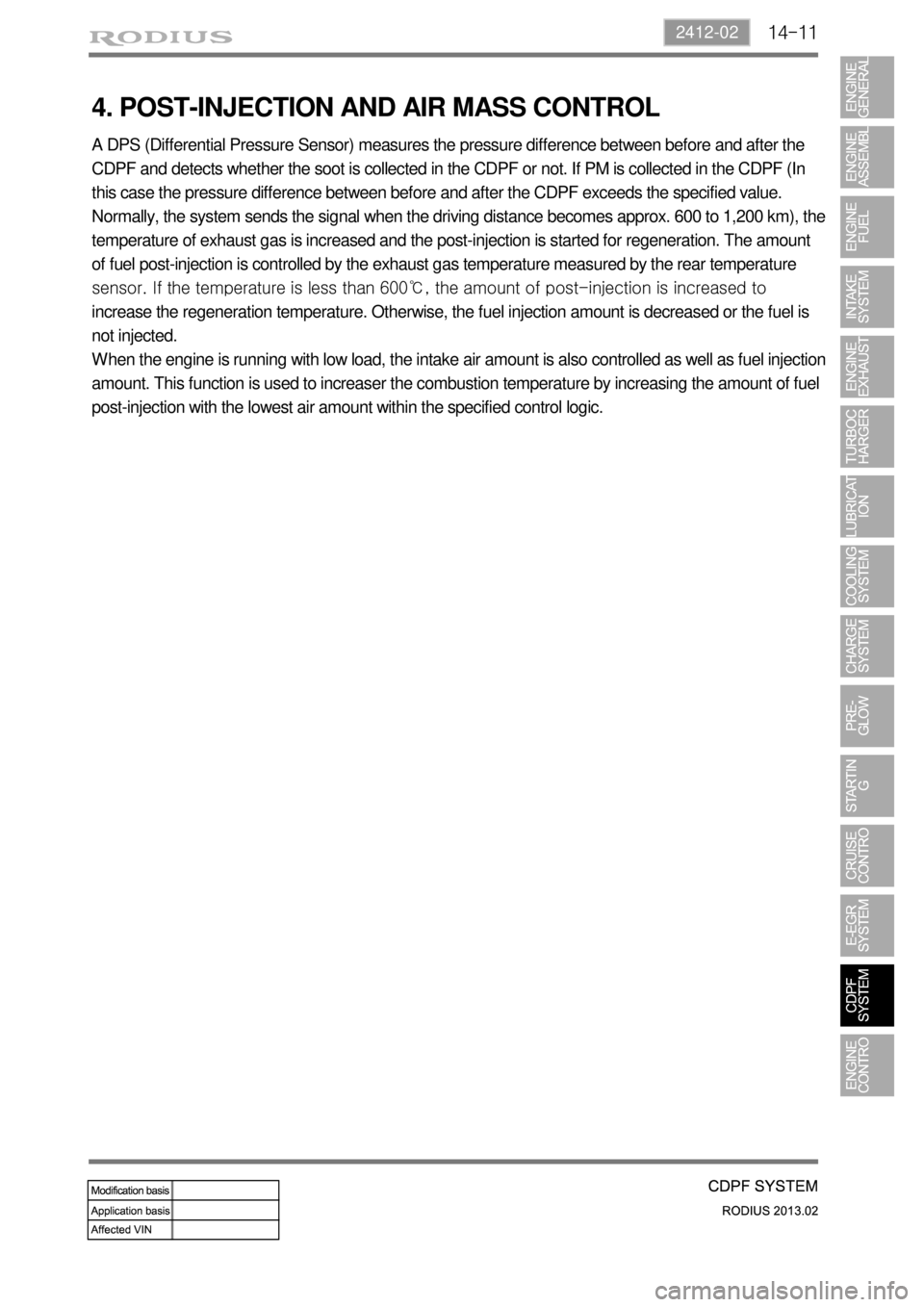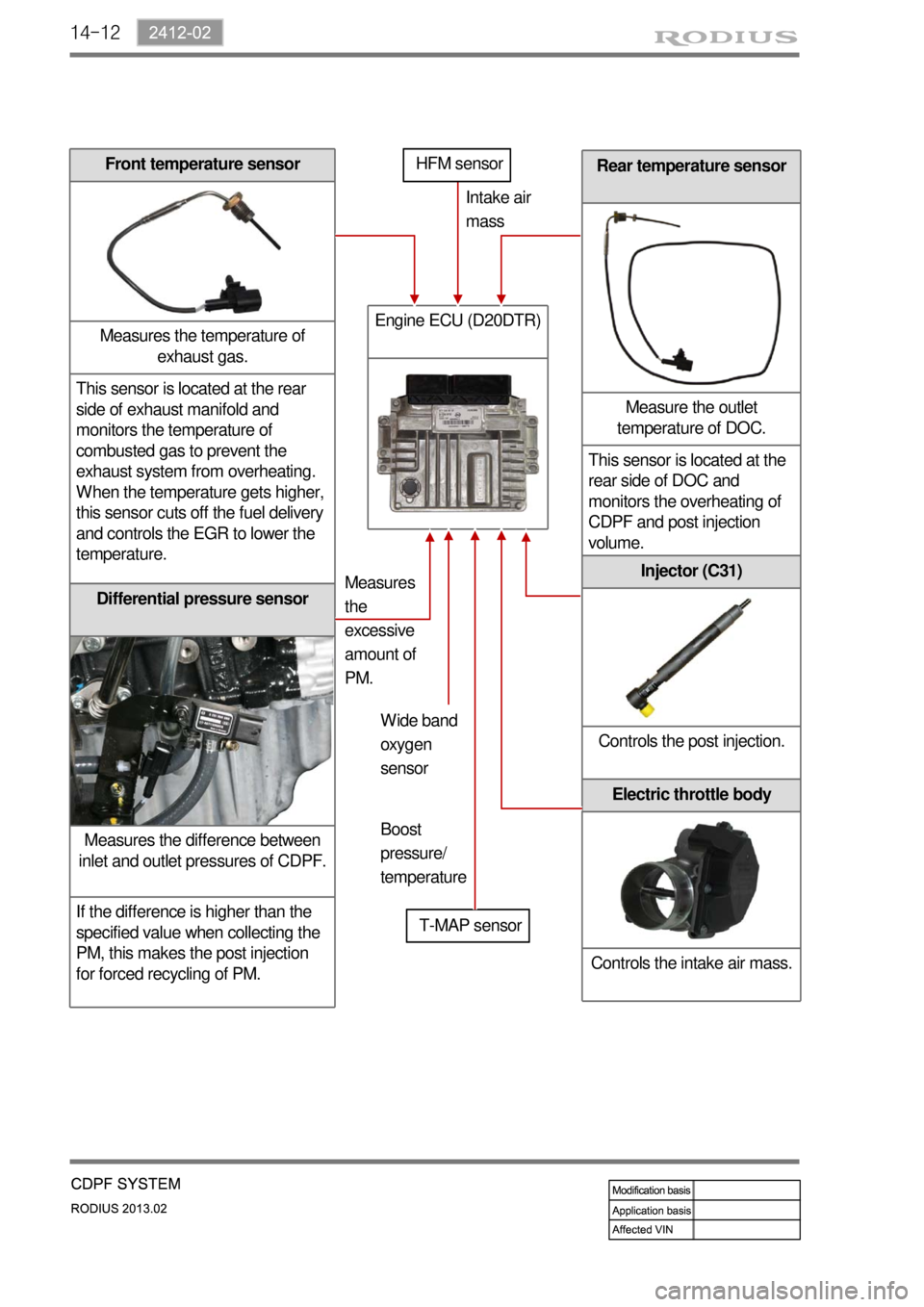Page 322 of 796
14-10
3. INPUT/OUTPUT DEVICES
Front temperature sensor: This sensor is installed at the inlet of DOC and detects whether the
DOC can burn (oxidize) the post-injected fuel or not.
Rear temperature sensor: This sensor is installed at the inlet of DPF and monitors that the
temperature of the exhaust gas is kept at 600℃. 1.
2.
If the temperature exceeds 600℃, the life of CDPF can be reduced. So the amount of fuel
post-injection is decreased.
If the temperature drops under 600℃, the rate of regeneration can be decreased. So the
amount of fuel post-injection is increased. -
-
Differential pressure sensor: This sensor checks the amount of PM collected by calculating the
pressure difference between before and after the CDPF.
Electric throttle valve: This valve reduces the intake air flow to raise the temperature of the exhaust
gas when the CDPF is operating during idling. 3.
4.
Page 323 of 796

14-112412-02
4. POST-INJECTION AND AIR MASS CONTROL
A DPS (Differential Pressure Sensor) measures the pressure difference between before and after the
CDPF and detects whether the soot is collected in the CDPF or not. If PM is collected in the CDPF (In
this case the pressure difference between before and after the CDPF exceeds the specified value.
Normally, the system sends the signal when the driving distance becomes approx. 600 to 1,200 km), the
temperature of exhaust gas is increased and the post-injection is started for regeneration. The amount
of fuel post-injection is controlled by the exhaust gas temperature measured by the rear temperature
sensor. If the temperature is less than 600℃, the amount of post-injection is increased to
increase the regeneration temperature. Otherwise, the fuel injection amount is decreased or the fuel is
not injected.
When the engine is running with low load, the intake air amount is also controlled as well as fuel injection
amount. This function is used to increaser the combustion temperature by increasing the amount of fuel
post-injection with the lowest air amount within the specified control logic.
Page 324 of 796

14-12
Rear temperature sensor
Measure the outlet
temperature of DOC.
This sensor is located at the
rear side of DOC and
monitors the overheating of
CDPF and post injection
volume.
Differential pressure sensor
Measures the difference between
inlet and outlet pressures of CDPF.
If the difference is higher than the
specified value when collecting the
PM, this makes the post injection
for forced recycling of PM.
Front temperature sensor
Measures the temperature of
exhaust gas.
This sensor is located at the rear
side of exhaust manifold and
monitors the temperature of
combusted gas to prevent the
exhaust system from overheating.
When the temperature gets higher,
this sensor cuts off the fuel delivery
and controls the EGR to lower the
temperature.
Engine ECU (D20DTR)
T-MAP sensorIntake air
mass
Measures
the
excessive
amount of
PM.
Injector (C31)
Controls the post injection.
Electric throttle body
Controls the intake air mass.
HFM sensor
Wide band
oxygen
sensor
Boost
pressure/
temperature
Page 326 of 796
14-14
1) Oxidation of DOC
The DOC oxidizes HC and CO of the exhaust gas in the two-way catalytic converter at 180℃ or
more, and performs best at the temperature between 400 and 500℃. The front EGT sensor
detects whether the DOC can burn (oxidize) the post-injected fuel or not, and sends the signal to the
ECU to maintain the DOC operating temperature between 300 and 500℃. The DOC reduces
CO and HC of the exhaust gas by redox reaction and also reduces small amount of PM.
Oxygen adheres to the catalyst materials: Less than 180℃
1.
CO and HC are oxidized by the catalyst materials: More than 180℃ 2.
Page 327 of 796
14-152412-02
2) Collecting PM of DPF
There is a filter installed in the DPF and the PM filtered by this filter is burned (regeneration) when the
temperature of exhaust gas is increased due to post-injection. The filter has a honeycomb-like
structure to capture the particulate matter and the inlet and outlet of each channel are closed
alternatively. Once the exhaust gas enters to the inlet of a channel, it is released from the outlet of the
adjacent channel through the porous wall because of the closed outlet of the first channel, and the PM
is collected in the first channel.
[Collecting PM of CDPF]
Normally, when the driving distance becomes approx. 600 to 1,200 km, enough amount of soot to
be burned is filtered and accumulated in the CDPF. The ECU increases the amount of fuel post-
injection to increase the temperature of the exhaust gas up to 600°C, so that the soot is
burned. The soot is burned for 15 to 20 minutes (may differ by conditions).
Page 329 of 796
14-172412-02
4) Fuel Injection During CDPF Regeneration
The injection method in D20DTR engine has three steps;
Pilot injection, Main injection, Post injection
Post injection ▶
The post injection is the injection process after main injection and consists of ‘After injection”,
“Post 1 injection” and “Post 2 injection”. All of post injections are to reduce the PM and
harmful exhaust gas. The post injection does not make the actual output. The post injection activates
the fuel by injecting the fuel to the incompletely combusted gas after primary combustion. Through the
process, the PM and smoke in the exhaust gas could be reduced. There are totally 7 injections as
shown in the figure. However, all of 7 injections are not performed during driving because it decreases
the fuel economy. Totally 5 injections can be performed in one cycle.
Page 334 of 796
15-6
Fuel Rail Pressure SensorFront EGT Sensor
Differential Pressure SensorCamshaft Position SensorRear EGT Sensor
Page 335 of 796
15-70000-00
Fuel Temperature
SensorCoolant Temperature Sensor
Knock Sensor (2)T-MAP SensorD20DTR ECU